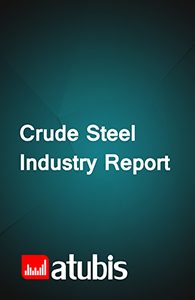Iran’s Crude Steel Market Outlook Report
9,680€
- TRY: 475,000 ₺
Crude steel comes in different forms such as slabs, billets and blooms, and ingots. Produced using continuous casting, slabs, billets, and blooms take the largest share of the crude steel market. Slabs are used to produce intermediate flat products (such as hot-rolled coil), while billets and blooms are used to produce long products (such as rebar and sections). Generally, almost all crude steel can be divided into two major categories based on production method: blast furnaces (BF) and electric furnaces (EF). EFs used in steelmaking include induction furnaces and electric arc furnaces (EAF). The economies of scale in BFs is generally better than that of induction furnaces; however, economic EAF capacities include a wider range of relatively small capacities rather than large ones.
Product Description
With a GDP of $415 billion in 2019, Iran was the third largest economy in the region that year. While the country’s economy was steadily growing after the drop in 2012 due to the sanctions, it dipped once again in 2019 thanks to the return of the sanctions. Iran’s massive iron ore reserves have been strong drivers of developments in the iron and steel industry; the country is the largest producer of iron ore in the region. Steel output in Iran has increased significantly over the past years; the country was the tenth largest producer on a global scale in 2019.
Market drivers of Iran’s crude steel
The Iran Vision 2025 has set a target of 55 million tonnes for crude steel capacity and 12 million tonnes of exports. Towards this goal, the government has made massive investments to build the required capacities. The government is expected to support the demand for crude steel and downstream sectors in line with the goals set in the Iran Vision 2025.
Construction and automotive are the main consumers of steel in Iran. Due to the sanctions and the surge in prices, both markets contracted; however, the industries are expected to have relative growth over the coming years, which will boost demand for steel products and consequently crude steel.
Owing to the increasing industrialization, the share of the manufacturing sector in Iran’s economy has increased. Along with industrial development, demand for steel as the most commonly used industrial metal will grow. The uptrend in the share of the manufacturing sector in the country’s economy is expected to continue over the coming years, driving demand for steel along with the growing industrialization.
Overview of Iran’s crude steel market
Most of the crude steel in Iran is produced by melting sponge iron in electric furnaces. Thanks to abundant access to natural gas as well as poor coal reserves, the country has made massive investment in direct reduction using gas and electric furnaces. It should be noted that most of the electricity used for melting sponge iron is generated in combined cycle power plants, which burn natural gas. Moreover, rich iron ore reserves also drive developments in the upstream parts of the iron and steel industry. Iran is planning to ramp up crude steel capacity to 55 million tonnes by 2025. Although ongoing projects can guarantee that goal, forecasts suggest relatively low operating rates for steelmakers in the country, mostly as a result of tight raw material availability. Yet, the country’s net exports of crude steel are expected to increase out to 2025, but tight raw material availability will put pressure on net exports afterwards.
Breakdown of Iran’s crude steel market
The crude steel market in Iran can be analyzed under three product categories: slabs, billets and blooms, and ingots. Billets and blooms account for a large share of the country’s crude steel output, which are used to produce long products. Crude steel products can also be categorized based on composition, including carbon steel, stainless steel, and alloy steel. Carbon steel has the largest share in Iran’s steel consumption, and it is the lowest-priced. Alloy steel is the next largest in terms of market share, while stainless steel has the smallest share but the highest prices. The country’s consumption of crude steel is also analyzed in terms of applications in steel products and consumer industries.
Key players in Iran’s crude steel market
- Esfahan Steel Company (ESC)
- Khouzestan Steel
- Khorasan Steel
- Hormozgan Steel
- South Kaveh Steel
- Arfa Steel
Additional Information
| Industry | Crude Steel |
|---|---|
| Region | Iran |
| Report Type | Industry Report |
Specifications
| Report Attribute | Details |
| The base year for estimation | 2021 |
| Historical data | 2011-2020 |
| Forecast period | 2021-2040 |
| Quantitative units | Value in USD and Volume in Tonne |
| Report coverage | Market Overview, Dynamics, Market Outlook, Risks to Forecast, Consumer Market, Industry Overview, Market Landscape, Competitive Landscape, Market Attractiveness, External Macro Environment Analysis |
| Segments covered | Source, Composition, Type, Application |
| Pricing and purchase options | Please explore our purchase options to meet your exact research needs. |
Reasons to Buy
- Recognize the geographical distribution of import demand
- Identify the current and future key players of the trading market
- Achieve a better insight on potential target markets
- Understand the behavior of major suppliers/customers either globally or regionally
- Identify competitors as a feed for market analysis
Table of Content
- Executive summary
- Introduction
- Objective
- Market under study
- Product
- Product specifications
- Consumption structure
- Applications
- Physical properties
- Subjects discussed
- Geographical scope under study
- Study timeframe
- Study currency
- Potential audience
- Market dynamics
- Market drivers
- Restraints
- Opportunities
- Challenges
- Market overview
- Market size
- Industry capacities
- Existing capacities
- Capacity distribution
- Geographical distribution of capacities
- Future capacities
- Existing capacities
- Output
- Output trends
- Operating rates
- Consumption
- Consumption trend
- Consumption Share of domestic product
- Trade
- Exports
- Imports
- Trade balance
- Market balance
- Market breakdown by product type
- Market breakdown by product type
- Market breakdown by application
- Inventory
- Producers inventory
- Consumers inventory
- Traders inventory
- Market outlook
- Market factors
- Raw materials
- Costs and prices
- Competition
- The government
- Other factors
- Future scenarios
- Risks to forecast
- Market factors
- Consumer markets
- End-user markets
- Building construction
- Infrastructure construction
- Transportation manufacturing
- Industrial equipment manufacturing
- Durable goods manufacturing
- Consumable goods manufacturing
- Direct consumer markets
- Major Direct consumers
- Existing capacities
- Drivers
- Major Direct consumers
- End-user markets
- Export potentials
- Destinations
- Trade and insurance costs
- Import market suppliers
- Producers potential share
- Destinations
- Industry overview
- Raw materials
- The supply volume of raw materials
- Supply channels of raw materials
- Raw materials procurement costs
- Cost structure of producers
- Production cost curve
- Industry value added
- Generated new scrap
- Technology
- Raw materials
- Market landscape
- Domestic sales markets
- Pricing in the domestic market
- Potential domestic demand
- Trade agreements for imports
- Foreign suppliers
- Foreign sales market
- Prices
- Potential markets overview
- Trade agreements for exports
- Foreign customers
- Domestic sales markets
- Competitive landscape
- Producers
- Company profile
- Revenue structure
- Gross profit margins
- Capacity, output and sales
- Consumers
- Company profile
- Revenue structure
- Gross profit margins
- Capacity, output and sales
- Producers
- Market attractiveness
- Industry rivalry
- Threat of new entrants
- Threat of substitutes
- Bargaining power of buyers
- Bargaining power of suppliers
- Conclusion of Porter analysis
- PESTEL analysis
- Political factors
- Economic factors
- Social factors
- Technology factors
- Environmental factors
- Legal factors
- SWOT analysis
- Large-scale companies with favorable conditions
- Short-term strategies
- Long-term strategies
- Large-scale companies with unfavorable conditions
- Short-term strategies
- Long-term strategies
- Small enterprises with favorable conditions
- Short-term strategies
- Long-term strategies
- Small enterprises with unfavorable conditions
- Short-term strategies
- Long-term strategies
- Large-scale companies with favorable conditions
List of Figures
- Output and consumption; 2011-2020
- Market share of product applications; 2020
- Market surplus; 2020-2040
- Production process flowchart
- Market size; 2011-2040
- Existing capacity; 2011-2020
- Capacity distribution; 2020
- Geographic distribution of capacities; 2020
- Development of future capacity; 2011-2040
- Amount of output; 2011-2040
- Operating rates of production plants; 2011-2040
- Amount of consumption; 2011-2040
- Consumption share of domestic product; 2011-2040
- Exports of product; 2011-2020
- Imports of product; 2011-2020
- Historical trade balance; 2011-2020
- Future Market balance; 2021-2040
- Market output breakdown by alloy type; 2011-2040
- Market consumption breakdown by alloy type; 2011-2040
- Market balance breakdown by alloy type; 2011-2040
- Market output breakdown by product type; 2011-2040
- Market consumption breakdown by product type; 2011-2040
- Market balance breakdown by product type; 2011-2040
- Market consumption breakdown by application; 2011-2040
- Inventories of raw materials and products at producers factories; 2011-2020
- Consumers’ inventory of product; 2011-2020
- Traders’ inventory; 2011-2020
- Production forecast, according to raw materials and sales analysis; 2020-2040
- Market surplus; 2020-2040
- The share of end-user industries in the consumption; 2011 and 2020
- Changes in the end-consumption of extrusion products; 2020 vs 2040
- Applications in building construction industry; 2020
- Applications in infrastructure construction industry; 2020
- Applications in transportation manufacturing industry; 2020
- Applications in industrial equipment manufacturing industry; 2020
- Applications in durable goods manufacturing industry; 2020
- Applications in consumable goods manufacturing industry; 2020
- Capacity distribution structure of direct consumers; 2020
- Existing capacities of direct consumers in each province; 2020
- Suppliers of the export potential destination; 2020
- Historical exports to the export potential destination and future potential; 2016-2040
- Up-stream domestic supply; 2011-2020
- Raw materials domestic supply; 2011-2020
- Supply channels of producer plants
- Spot price of raw material in the market; 2011-2040
- Cash cost structure for production the product; 2020
- Production cost curve of the plants; 2020
- Gross value added of the industry; 2011-2020
- Generated new scrap; 2011-2020
- Sales channels
- Realized price of the product in the market; 2011-2040
- Potential demand of each province; 2020
- The main foreign suppliers to the market; 2011-2020
- FOB price vs domestic market; 2011-2040
- Map of global major importers > 20,000t; 2020
- Major foreign customers; 2011-2020
- Revenue structure of the producers; FY2020
- Sales income and gross profit margin of the producers; FY2011-2020
- Output and sales of the producers; FY2011-2020
- Revenue structure of the consumers; FY2020
- Sales income and gross profit margin of the consumers; FY2011-2020
- Output and sales of the consumers; FY2011-2020
- SWOT matrix for large-scale companies with favorable conditions
- Strategies positioning for large-scale companies with favorable conditions
- SWOT matrix for large-scale companies with unfavorable conditions
- Strategies positioning for large-scale companies with unfavorable conditions
- SWOT matrix for small enterprises with favorable conditions
- Strategies positioning for small enterprises with favorable conditions
- SWOT matrix for small enterprises with unfavorable conditions
- Strategies positioning for small enterprises with unfavorable conditions


